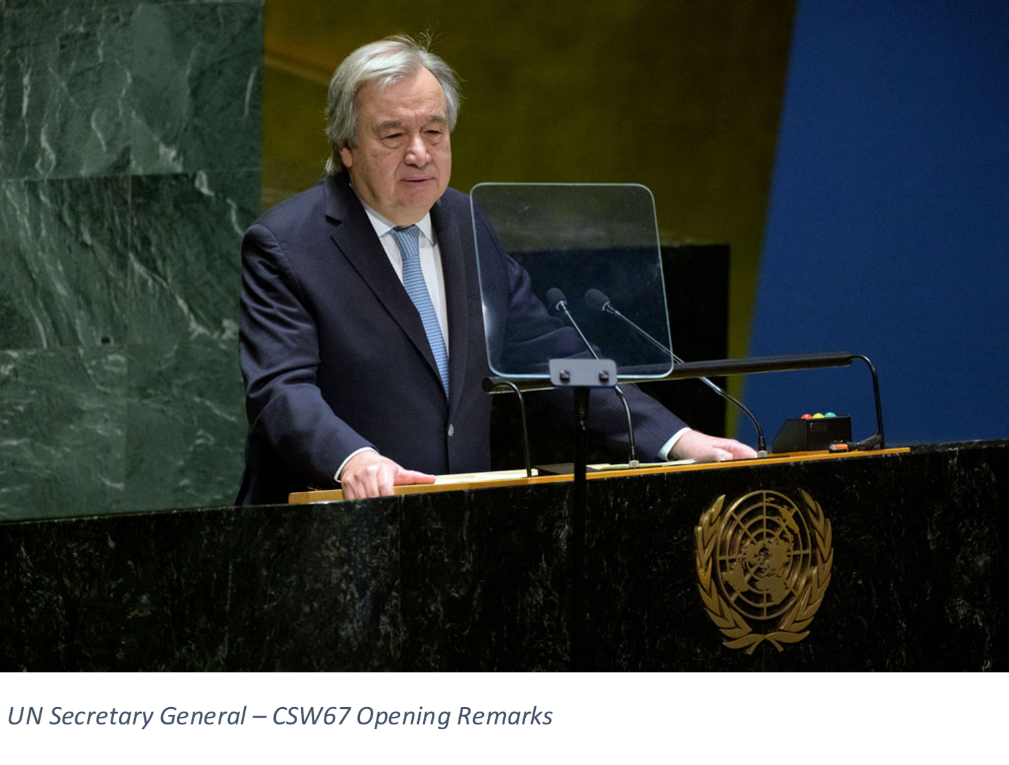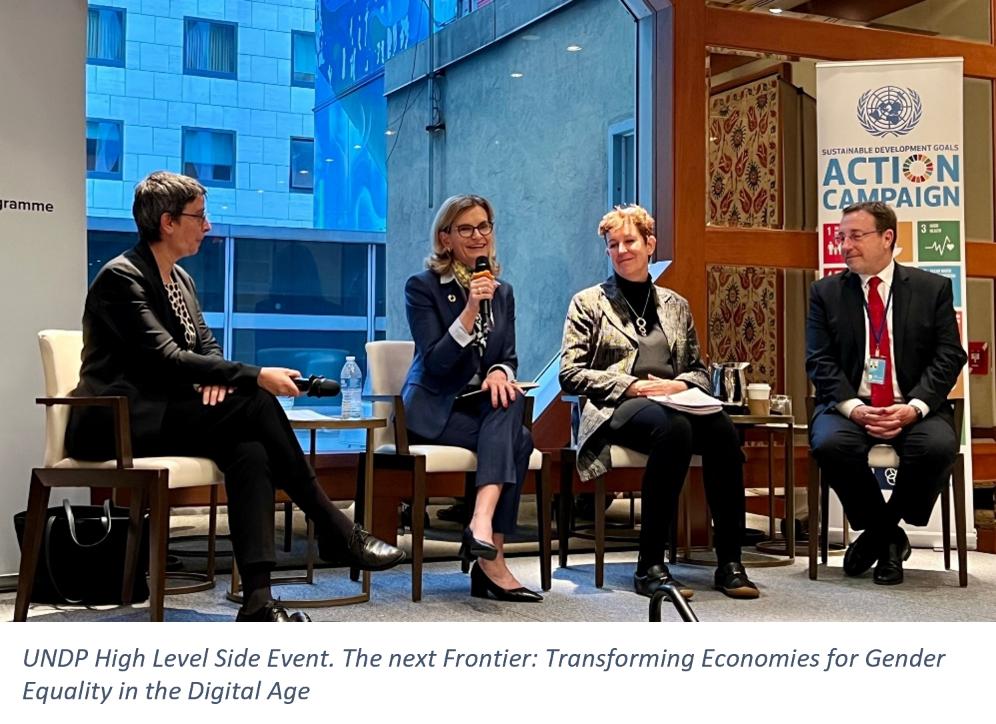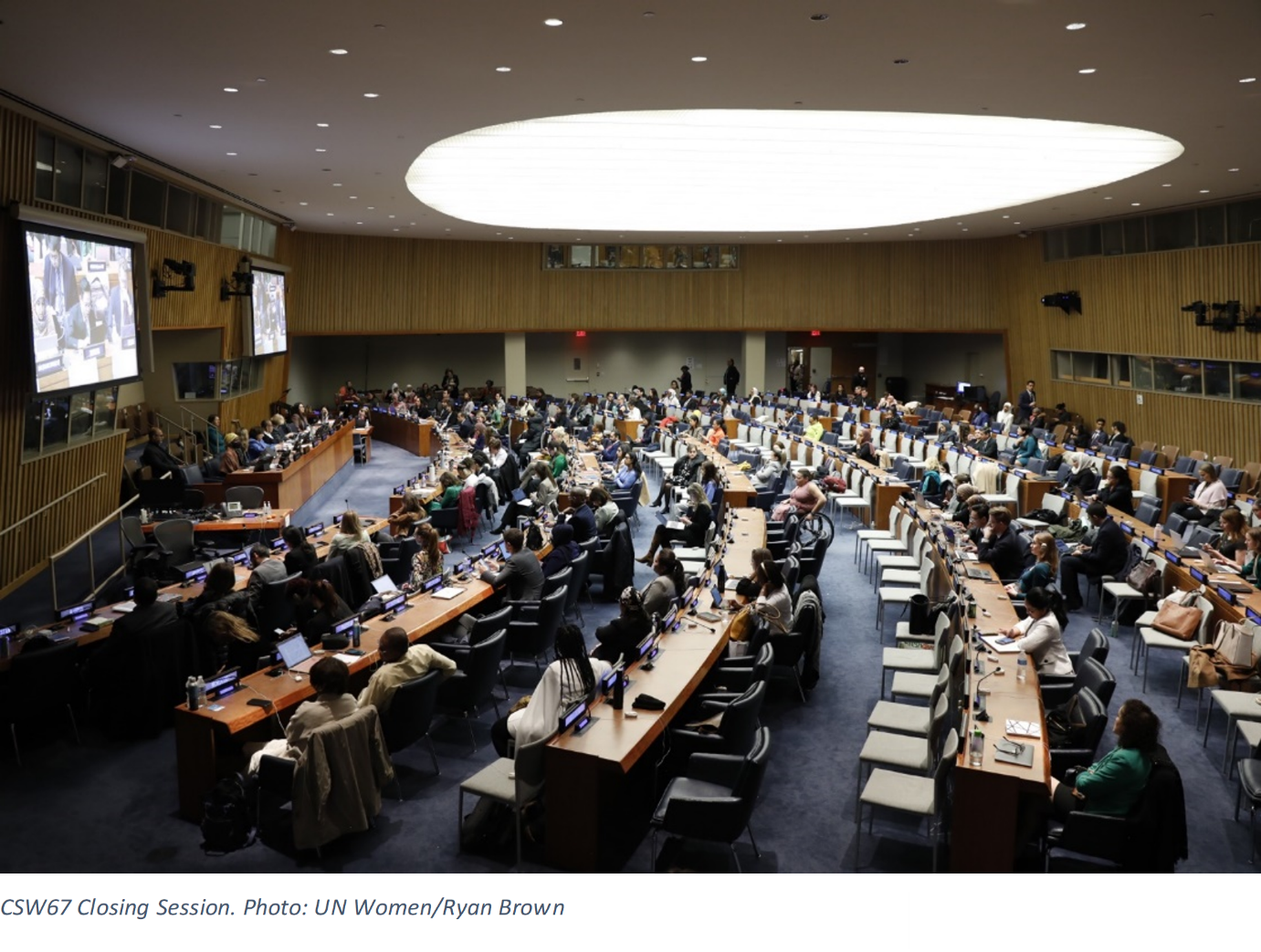CSW67 Summary and Way Forward
CSW67 ‘Innovation and technological change, and education in the digital age for achieving gender equality and the empowerment of all women and girls’ has come to an end and for the first time digital, technology and innovation took center stage in the discussions of the commission, bringing a vision on how new technologies and digital can contribute to gender equality. This year’s CSW was also relevant because it was the first time face-to-face commission to take place in three years after the Covid-19 pandemic erupted, gathering more than 7,000 participants, including 4 heads of State and government and 116 ministers, 205 side events on UN premises, and about 700 NGO parallel events.
This year’s innovation is that youth leaders took center stage in the official negotiations for the first time. More than 40 youth speakers took the floor, many spotlighted the difficulty of being included in a process which enables their participation, both in decision-making on national and global platforms as well as within the Commission, itself. Youth delegates emphasized the essential need to ensure that no one is left behind, particularly women and girls in rural and marginalized areas, gender minorities and persons with disabilities. A major issue discussed during the dialogue was the prevalence of online violence and hate speech against women and girls.
It’s also the first time that the CSW Committee agreed at the beginning of the negotiations not to discuss or have open discussion about agreed language, helping to get agreed conclusions faster. Regardless of this agreement, few conservative governments kept questioning issues linked to sexual and reproductive rights, sexual orientation, gender identities and intersectionality, among others.
SUBSTANTIVE DISCUSSIONS
- One of the topics taking big part of the discussions has been online or technology-facilitated gender-based violence. The recognition of the magnitude, of the harms that causes, but also the need to adopt a comprehensive definition of technology-facilitated VAW, as well as international methodological guidance, to understand and track patterns of harm and rights violations to guide evidence-based policymaking and programming; and develop and expand legislation, policy actions, around principles focusing on human-rights and survivor-informed approaches, transparency, accountability and proportionality. Big push from UNW and experts to understand this as a continuum and interrelation between offline and online violence, harassment and discrimination against women and girls.
- Heads of State, ministers and senior officials of regional blocs and groups and Member States concentrated many of their interventions in the need to close the gender digital divide -- and improve general literacy and digital skills across populations – and also highlighted the need to ensure a safe digital environment as well as ensure the full participation of women and girls in STEM.. Delegates spotlighted the benefits of women and girls having access to digital resources, while also calling for more protective measures. Others called for more opportunities to be available to women leaders and innovators and for the public and private sectors to make more available funding that enables the full participation of women and girls in the technology ecosystem.
- Women’s and feminist’s organization raised a wide range of issues related to technological advancement linked to growing global inequalities, and concentration of power and wealth. Recurring themes have been the digital gender gap, and the proliferation of gender-based violence and the exclusion of women and girls from decision-making spaces. Many CSOs also underscored the importance of inclusion, gender equitable assistive technology and gender transformative approaches in achieving gender equality in the digital spheres. Many advocates proposed solutions: from neutral global internet to help protect human rights and promote women’s access to online spaces, to make governments and big tech more accountable through standards and regulations, inclusion of indigenous voices in decision-making spaces and more.
- Other discussion has been also how to move from number of women accessing to internet, or new technologies to the STEM gap, and how women can be also leading the design of the future. Being at the center of the challenges gender stereotypes and negative social norms. Innovation and digital should challenge gender stereotypes and negative social norms and biass, including through the development of digital content, artificial intelligence (algorithms), to education programmes.
KEY HIGHLIGHTS OF THE AGREED CONCLUSIONS
- CSW acknowledges that achieving gender equality and the empowerment of all women and girls and women’s full, equal effective and meaningful participation and decision-making in the context of innovation and technological change, and education in the digital age is essential for achieving sustainable development, promoting peaceful, just and inclusive societies, enhancing inclusive and sustainable economic growth and productivity, ending poverty in all its forms and dimensions everywhere and ensuring the well-being of all.
- CSW condemns all forms of violence against women and girls, which are rooted in historical and structural inequalities and unequal power relations. All its forms and manifestations, online and offline, in public and private spheres, are pervasive, underrecognized and underreported, particularly at the community level.
- CSW recognizes the magnitude of technology-facilitated online gender-based violence and the significant physical, sexual, psychological, social, political or economic harm it causes to women and girls, infringing on their rights and freedoms, in particular for those facing multiple and intersecting forms of discrimination and those in public life. CSW recognizes that gender inequality is the root cause of all forms of gender-based violence, including offline and online forms. The commission also recognizes the need to adopt a comprehensive definition of technology-facilitated VAW, as well as international methodological guidance, to understand and track patterns of harm and rights violations to guide evidence-based policymaking and programming; and develop, amend and expand legislation, improve coherence of policy actions, around principles focusing on human-rights and survivor-informed approaches, transparency, accountability and proportionality.
- CSW calls for significantly increased public and private sector investments to bridge the gender digital divide, more inclusive innovation eco-systems, and the promotion of safe and gender-responsive technology and innovation.
- CSW recognizes that negative social norms and gender stereotypes are causing persistent gender gaps in STEM education, preventing women’s equal participation in the technology workforce, especially as content creators and entrepreneurs, and keeping them from attaining and retaining jobs in those fields. It emphasizes the need to leverage digital technologies to improve and supplement teaching, rather than replace in-person education.
- CSW recognizes that the integration of a gender perspective in innovation and technological change will be essential for reaching gender equality.
|
Initiatives to promote innovation and technological change, and education in the digital age for achieving gender equality must consider the following:
|
CSW67 KEY ACTORS AND UNDP’S ENGAGEMENT

- The SG opening remarks and the language he used was strong. Mentioning loud and clear how some countries reject the gender perspective language, talking about centuries of patriarchy, of course Afghanistan but also the big tech industry “we cannot let the silicon valleys of the world be the death valleys for women’s rights”. He remarked that the gender digital divide is fast becoming the new face of gender inequality. He also highlighted how women and girls around the world are experiencing growing threats and harassment in the digital world and asked for a collective action worldwide by governments, civil society and the private sector invest more in bridging the digital gender divide, especially by providing gender-responsive education and improve skills training, opportunities and access in STEM. These are priorities flagged by him:
>>Digital divide
>>Leadership of women
>>Addressing violence- safe environment and increase accountability.
- Challenges faced by women’s organizations: CSOs and feminists increased questioning the legitimacy of CSW held in NY as they felt this year more than ever a big disbalance: official event at the UN Secretariat, and almost all CSO’s side event outside this venue. They also raised a concern on the language used in the agreed conclusions – for not being very progressive - and asked to go further and address systemic gender equality and broader agenda of structural inequalities or climate change; big concentration of power and wealth including the big tech industry - artificial intelligence (one out of 5 working in AI is women); and the uneven distribution of power and financial resources, as well as creating further structural and systematic barriers.
- The Secretary-General also organized a Townhall meeting with civil society members, where the need to ensure in-person access to CSW for relevant stakeholders from all parts of the world, including youth, was highlighted. Representatives from civil society organizations also discussed the need to support women and girls in crisis settings, such as Ukraine and Afghanistan. The on-going women’s movement in Iran was also mentioned as a key example of women and girl’s resilience.

- UNDP presence and influence – UNW is at the lead of negotiations. We co-hosted 11 global and regional side events including one High Level event with the participation of UNDP Administrator and ITU Secretary-General, but also academia and three directors of women’s and philanthropic organizations. In total we gathered more than 1,500 participants -- in-person and online -- that focused on a wide range of topics from innovation and the Women, Peace and Security Agenda, gender climate justice and digital technologies, to the elimination of technology-facilitated violence against women politicians.
- CSW was also an opportunity to engage UNDP senior managers including Crisis Bureau Director – Asako Okai-, BERA Director – Ulrika Modéer -, RBLAC Director – Michelle Muschett -, RBAS Director a.i. - Kanni Wignaraja-, RBEC Director - Ivana Živković- and RBEC Deputy Director - Marina Walter-.
- We engaged across the globe with a wide range of national activities to commemorate International Women’s Day and women’s history month, including national events and conferences, press clubs, social media campaigns and varied comms pieces and even women’s bazaars.
- CSW67 also helped us engage bilaterally with a wide range of partners: from gender committee of the European Parliament, the UN Special Rapporteur on Violence Against Women to Executive Directors of two big women’s organizations – AWID and Women Deliver - the World Bank, Gender@Work and others.
THE WAY FORWARD - What is relevant for UNDP?
- Relevant for UNDP is the big gap identified at the policy level: 40 percent of the countries have no meaningful policies or programmes for improving women’s access to the Internet, and there are also relatively few countries offering online services that may be of particular benefit to women -- only 43 countries allow users to apply online for child benefits, and only 45 countries allow users to apply online for maternal or newborn benefits --. Many countries have digital strategies focused on broadband development, e-governance, AI or digital skills, but often gender is a siloed domain that is not integrated properly in a broader LNOB framework .
- During the pandemic, UNDP assisted 82 countries to quickly adopt essential digital responses, including in solutions to address gender inequalities and promote women’s empowerment. Since then, we have expanded our digital support to over 100 countries, where digital is at the forefront of our future-ready programmes, aimed at realizing human gains. Currently UNDP is supporting 40 countries with Digital Readiness Assessments, an untapped opportunity to ensure we include a strong gender focus that later can translate into gender transformative national digital strategies, policies and ultimately truly inclusive digital transformation journeys and digital ecosystems.
Three areas where UNDP under can take the lead are:
- Disinformation and counter digital and technology-facilitated GBV: leveraging our experience with the Spotlight Initiative currently reaching more than 90 countries.
- Ensure national digital strategies and policies, digital transformation journeys and ecosystems are gender responsive: leveraging the work with the Digital Readiness Assessments in 40 countries.
- Leverage digital technologies to transform economies that work for gender equality: keep expanding our work on digital and care -- care georeferencing tool created by RBLAC --, expand our women innovators programs to reach global scale, scale the STEM4ALL Platform efforts lead by RBEC to nurture the next generation of STEMinists, work in the development of grassroots innovations to tackle structural gender inequalities leveraging the power of the Accelerator Labs currently working in 115 countries, and keep developing Fintech and e-commerce solutions that support the digitalization of women-led MSMEs.


Please log in or sign up to comment.